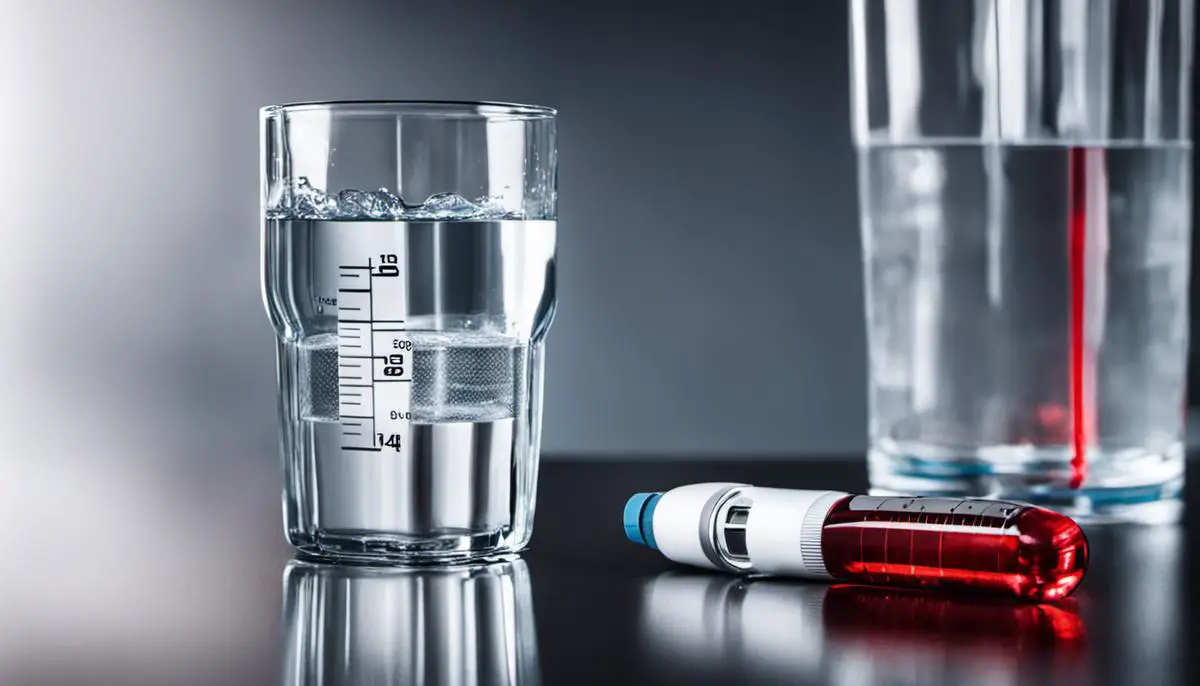Health is a resource that we often take for granted until we experience a wake-up call. One such call may be an unusual urge to quench your thirst continuously, a symptom that, while seemingly innocuous, may hint at an underlying health issue like diabetes. For males in specific, this symptom might be an early red flag pointing towards diabetes, a globally prevalent condition with potentially severe complications. Through this discussion, we aim to unpack this intersection by first illuminating our understanding of thirst and its mechanisms, before delving into the nitty-gritty of diabetes and its implications. We will then focus on increased thirst as a symptom of diabetes in males, ending with guidance on consultation, diagnosis, and treatment procedures.
Understanding Increased Thirst
Understanding the Role of Thirst
Thirst is a natural sensation that triggers the need to drink fluids. It arises when the body’s hydration levels drop, signaling the brain to induce feelings of thirst. This mechanism helps to maintain optimal hydration levels, crucial for numerous bodily functions like nutrient transportation, temperature regulation, and maintaining skin health.
The Pathology of Persistent Thirst
Persistently increased thirst, also known as polydipsia, is, however, not a usual occurrence and may signal a health problem. The sensation of thirsty arises from the hypothalamus after it receives signals from the body about low fluid levels or high salt content. In certain circumstances, these signals can become amplified or continuous due to illness, causing frequent or constant thirst.
Different Causes of Increased Thirst
Several factors can cause increased thirst, including but not limited to intense exercise, eating salty food, and arid weather conditions. Health-related reasons for a persistent feeling of thirst range from simple dehydration to more serious conditions like diabetes, kidney disease, or liver problems. Certain medications may cause dry mouth, leading to increased thirst.
Increased Thirst in Diabetes
In the context of diabetes, particularly in males, increased thirst is often identified as a common symptom. This occurs due to the high levels of glucose in the bloodstream. With diabetes, the body is unable to properly utilize or produce insulin, a hormone that facilitates the movement of glucose into cells for energy. The surplus glucose remains in the bloodstream, pulling water from tissues. This induces a chain reaction, resulting in frequent urination, which in turn leads to dehydration, and subsequently provoking intense thirst.
Hormonal Effects and Gender Differences in Diabetes Symptoms
Hormonal fluctuations can affect the presentation of diabetes symptoms, including increased thirst. Men, having less estrogen and progesterone, which can impact insulin sensitivity, may experience symptoms like increased thirst more noticeably.
Recognizing Other Diabetes Symptoms and Seeking Help
Besides increased thirst, other common symptoms of diabetes include frequent urination, unexplained weight loss, fatigue, blurred vision, and slow-healing sores. It is essential for anyone experiencing persistent alterations like increased thirst unexplained by diet or activity changes to seek medical attention to rule out conditions such as diabetes.
Monitoring and Management of Diabetes
If diabetes is diagnosed, the condition requires continuous monitoring and management, including regular glucose level checks, following a balanced diet, daily exercise, and following prescribed medication and insulin therapy regimens. Maintaining a healthy lifestyle is crucial for managing diabetes symptoms and avoiding long-term complications. Regular check-ups can aid in detecting and treating any health issues at early stages.
Addressing Diabetes: Learning from Clinics, Support Groups, and Healthcare Professionals
An abundance of resources are waiting to be utilized by individuals who have been diagnosed with diabetes. These include clinics specializing in diabetic care, educational resources, and various support groups. Professionals in the field of healthcare are ready to provide individual advice along with strategies for preventing complications linked to diabetes. Aside from guidance, they can also assist in developing essential management skills required for living with a lifelong condition such as diabetes. It cannot be stressed enough how crucial it is for patients to engage proactively in their own healthcare, strive to understand their condition and the techniques to manage it, and never hesitate to seek necessary medical help. Ultimately, the power to combat diabetes springs from knowledge.

Diabetes: An Overview
Demystifying Diabetes
Often discussed but not always fully understood, diabetes is a chronic health issue that affects how your body handles blood sugar or glucose. This is primarily classified into two categories known as Type 1 and Type 2 diabetes. Type 1 diabetes, commonly diagnosed during childhood or early adulthood, is an autoimmune condition. This occurs when the body lacks insulin production due to the immune system’s attack and destruction of insulin-producing cells found in the pancreas. On the other hand, Type 2 diabetes, which is the most typical type, develops when the body either resists the effects of insulin or simply doesn’t generate sufficient insulin.
Causes and Risk Factors of Diabetes in Males
While the exact cause of diabetes is unknown, some factors increase the risk of developing Type 2 diabetes. These include obesity, age, family history of diabetes, lack of physical activity, poor diet, high blood pressure, and abnormal cholesterol levels. Specific to men, low testosterone levels can be a risk factor for developing diabetes due to its relationship with insulin sensitivity and obesity.
Increased Thirst as a Symptom of Diabetes
One of the earliest and most common symptoms of diabetes is increased thirst, also known as polydipsia. High levels of glucose in the blood can lead to dehydration and cause you to feel thirsty. The kidneys work overtime to get rid of the excess sugar, increasing the need to urinate, which further dehydrates the body and consequently results in a higher need for fluid intake.
Other Common Symptoms and Complications
In addition to increased thirst and frequent urination, other symptoms of diabetes may include unexplained weight loss, constant hunger, blurry vision, slow-wounding sores, fatigue, and frequent infections. If left uncontrolled, diabetes can lead to serious complications such as heart diseases, stroke, kidney diseases, eye problems, dental diseases, nervous system damage, and foot problems.
Complications Specific to Men
Men with diabetes face unique challenges as the disease can worsen with sexual and urologic problems. Diabetes can damage blood vessels and nerves in the sexual organs, leading to erectile dysfunction. It may also cause retrograde ejaculation, where semen goes into the bladder instead of out through the penis during an orgasm. Additionally, diabetes can lead to bladder control problems and urinary tract infections.
Becoming aware and informed about the symptoms of diabetes, particularly an unusual increase in thirst, is crucial. Detecting and tackling the disease at an early stage offers substantial benefits in terms of slowing down its progression and minimizing potential complications. Regular health check-ups and upholding a healthy lifestyle serve as two effective ways to manage diabetes.

Increased Thirst as a Symptom of Diabetes in Males
The Link between Unusually High Thirst and Diabetes
An unusual thirst increase, also known scientifically as polydipsia, is closely linked with diabetes, especially in males. Diabetes leads to an abnormal increase in blood sugar levels, which your kidneys struggle to manage, resulting in excess sugar being expelled in your urine. This process also pulls out fluids from your tissues, leading to frequent urination. You, therefore, feel thirstier as your body attempts to replace the lost fluids.
The Underlying Science
In physiological terms, when glucose accumulates in your bloodstream, your kidneys start working strenuously to filter and absorb the excess sugar. If they can’t keep up, all this surplus glucose gets excreted in your urine, causing more frequent urination. As this continues, it results in a loss of calories and an increase in thirst. The interaction between thirst and urination can enhance your chance of dehydration and induce even more thirst, creating a vicious cycle.
Diabetes Types and Thirst Levels
Both type 1 and type 2 diabetes can result in increased thirst due to high blood sugar levels and frequent urination. However, this experience can differ depending on the individual and the type of diabetes. Please note that increased thirst doesn’t necessarily mean a definite diagnosis of diabetes; it could also be a symptom of other health conditions.
Recognizing Increased Thirst as an Early Sign
Increased thirst is often one of the earliest symptoms of diabetes in men. This excessive thirst might be accompanied by other symptoms such as frequent urination (especially at night), fatigue, unintentional weight loss, and constant hunger. Recognizing these symptoms promptly can lead to early diagnosis and management of diabetes.
The Importance of Expert Commentary and Consultation
Informed medical advice is key in understanding and managing diabetes. Experts opine that regular check-ups are crucial to ensure early interception of diseases like diabetes. If men experience consistent excessive thirst, consulting a healthcare provider becomes crucial to either confirm or rule out the onset of diabetes.
An Overview of Increased Thirst – A Key Indicator of Diabetes
Numerous scientific findings have emphasized the relationship between persistent thirst and the likelihood of developing diabetes, particularly among males. For instance, a research study in the New England Journal of Medicine noted a consistent connection between these variables, prompting their recommendation for men experiencing these symptoms to undergo blood sugar testing. Similarly, a comprehensive study showcased in Mayo Clinic’s Proceedings surmised that patients presenting constant thirst and frequent urination were more likely to be diagnosed with diabetes, underscoring the importance of early detection for managing the disease most effectively.

Consultation, Diagnosis, and Treatment
Delving Deeper: The Role of Increased Thirst in Understanding Diabetes
Diabetes Mellitus, characterized as a chronic disease due to the body’s struggle with effectively regulating blood glucose levels, often presents with significant symptoms such as increased thirst, medically termed polydipsia. This symptom is commonly seen in both diabetes type 1 and type 2, and it frequently arises among males.
The root of increased thirst lies in an accumulation of sugar in the bloodstream. In response to elevated blood sugar levels, the body strives to flush out the extra sugar through urination. As a result, a thirstier state is triggered due to the body’s increased need for fluids. This continuous cycle is a classic sign of untreated diabetes and can help lead to a diagnosis when diabetes symptoms are suspected.
Consulting A Healthcare Provider
Experiencing new, unexplained symptoms such as increased thirst is a potent reason to consult with a healthcare provider. It is crucial to remember that persistent thirst alongside other symptoms such as frequent urination, constant hunger, weight loss, fatigue, or blurred vision can indicate diabetes. However, these symptoms can be easily overlooked or attributed to other causes, particularly in the initial stages of the disease.
On consultation, your healthcare provider will take a detailed medical history, assess your symptoms, and likely recommend various tests. These commonly include a fasting blood sugar test, an oral glucose tolerance test, or a glycated hemoglobin (A1C) test.
Diagnosis and Treatment
Diabetes diagnosis is usually based on persistently high blood sugar levels. The type of diabetes is determined by the specific characteristics of the disease, such as the presence of certain autoantibodies in type 1 diabetes or insulin resistance in type 2 diabetes. Once the diagnosis is made, the treatment focuses on managing symptoms and maintaining normal blood sugar levels to prevent further complications.
Treatment may include medications, insulin therapy, and lifestyle modifications such as managing diet, exercising regularly, and maintaining a healthy weight. In some cases where the blood sugar is not controlled by these measures, insulin injections may be necessary.
Prevention and Management of Diabetes
Preventing diabetes involves maintaining a healthy lifestyle. This includes regular exercise, a balanced diet, maintaining a healthy weight, and avoiding tobacco and excessive alcohol consumption. Routine health screenings for blood glucose levels can also aid in early detection and management of the disease.
For individuals diagnosed with diabetes, effective management involves a combination of medical treatment and lifestyle adjustments. Regular monitoring of blood sugar levels, taking prescribed medications, following a healthy diet, engaging in regular physical activity, and regular health check-ups are key to preventing complications from diabetes.
Hence, the occurrence of increased thirst in males could be a symptom of diabetes, and should prompt immediate consultation with a healthcare professional. With accurate diagnosis and treatment, diabetes can be managed effectively, and the symptoms, including increased thirst, controlled. Regular health check-ups and lifestyle modifications can also aid in minimizing the risk of developing diabetes.

Diabetes is a health concern that presents a host of challenges, affecting both life quality and long-term health outcomes. A simple symptom like increased thirst can, in some cases, be an early sign of this disease, especially in males. Hence, recognizing such symptoms can be a critical step towards prompt diagnosis and effective treatment. Equally important is the knowledge on how to seek medical help, the process of diagnosis, various treatment and management options available. Though the battle with diabetes might seem daunting, a better informed and proactive stance towards detection and management can be the frontier for healthier outcomes. Remember, health is not simply the absence of disease; it involves being informed, vigilant, and proactive about your personal well-being.
